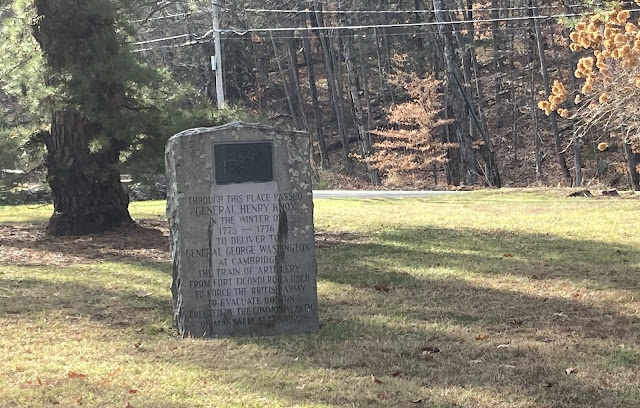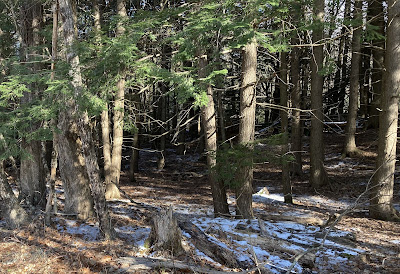The Bidwell House, Part II: “One Of Our Geniuses Had Been Bundling All Night”
Ensign Samuel Armstrong of the 8th Massachusetts Regiment of the Continental Line is one of those who traveled through the Berkshires during the Revolutionary War, transporting supplies for the Continental Army.
On July 19, 1777, he set off west from Blandford with four teams of oxen and 20 men. His day was trying, beginning in the morning when one of the teamsters hired failed to show up. Searching, he found “... one of our Genius's had as I suppos[ed] [b]een Bundling all Night & had not got the Snarls out of his head, for I catch'd his Girl Combing it as I entered the door (the fellow look'd as if he'd nev’r Seen me before & Quite forgot his promise he'd made the last Evening; besides that his Oxen were lame; the Cart did not belong to him, & more than that the Owner of the Cart said his Cart should not go) upon which I told him his Oxen & Cart Should Both go & if he was amind to go with them he might, if not one of the men Shoud drive them as farr as we wanted to go & he might come after them…” [1]
After traveling six miles with his party they stopped for a rest, “...but could get nothing to Eat nor drink except Water…” That evening they stayed at Spring’s tavern, which he listed as being in Sandisfield, and where he learned one of their carts had broken down along the way. [2]
The following morning he set out, this time with three wagons and 24 men, traveling six miles to Brewer’s tavern in Tyringham where they ate breakfast before continuing on to Great Barrington. The following morning they drew five days worth of provisions to sustain them on their journey, but reaching “Nobletown” (now part of Hillsdale, New York) he stopped at Kenyon’s tavern where he would “Eat dinner of baked Pigg”. [3]In the winter of 1775-1776 the roads through the southern Berkshires were used by Colonel Henry Knox to transport captured British cannon to George Washington’s army outside Boston. Today the general route they followed is marked by monuments placed along the way from Fort Ticonderoga, New York, to Cambridge, Massachusetts, including this one in Russell.
Armstrong and his companions, and Knox and his train of artillery, were not the first or only Revolutionary War soldiers to travel this way. On April 21, 1775, a company of minutemen left Great Barrington, bound for Boston after receiving news of the fighting at Lexington and Concord. Two regiments from the area participated in the siege, including a company under Noah Allen from Tyringham. [4]
The Bidwell House was, at the least, near the route to Cambridge, Massachusetts, taken by some of the captives from Burgoyne’s army surrendered at Saratoga, New York on October 17, 1777 and Burgoyne himself. Germans troops marched south first through the upper Hudson River Valley, then east to Great Barrington and on through the Berkshires.
Brigadier-General John Glover, who planned the march of what became known as the “Convention Army” explained to George Washington: “I was honoured with the command of conducting him [Burgoyne] and his Troops from Saratoga to Cambridge; for the better supplying of which & the conveniency of the Inhabitants of the country through which they marched, I divided them into two Divisions; The British by Williamstown & Northampton; the Germans by Kinderhook & Springfield,...” [5]
A German officer recalled that after leaving Great Barrington on the morning of October 26th “... our march went through Tyringham, through woods and real wildernesses. We were wrong in cursing the abominable roads, for we found them worse later. At first we wandered in the edge of a great, wild, hilly district called Green wood, to which you may send naughty children if you want to frighten them. After coming seventeen miles, we slept in this American Caucasus, and to help matters it rained all night.” [6] A second account noted: “Our march went through Tyringham today … We marched 10 miles further still to Greenwood. The march went through woods and real wilderness where we encountered no more than 7 or 8 wretched dwellings. The roads were as bad as we had ever seen in America. They were not only very hilly but also stony and rocky and in many places so swampy that the men sank up to their knees.” [7]
The Memoirs and Letters and Journals of Major-General Riedesel indicate, though without reference or footnote: “On this day [26th], the troops marched fifteen miles and were forced to encamp near Spring's house in terrible weather. Several of the men had already remained behind, in consequence of fatigue and want of shoes.” [8] Some would reach Westfield on the 27th, others the 28th. As captives, and generally not welcome, they fared poorly. Brunswicker Grenadier Johann Bense noted that in Blandford on the 27th: “today, we were supposed to be quartered in a house designated for our company, but the farmer did not want to take us. He was very bold. … We found an old cellar near by and spent the night there.” [9]One of the most notable figures to pass through this area was British Lieutenant-General John Burgoyne, after his capture at Saratoga, escorted by Brigadier-Generals John Glover of the Continental Army, and William Whipple of the New Hampshire militia. Some historians question accounts of Burgoyne’s passing through Great Barrington and Westfield, and argue his trip took him further north through Franklin and Hampshire Counties. Whipple’s journal clearly puts Burgoyne in Hampden (then southern Hampshire) County. Whipple, a member the Continental Congress and signer of the Declaration of Independence, recorded leaving Great Barrington on October 30th and staying that night at Chadwick’s tavern, then continuing on the 31st, by way of Otis and “...Springs [tavern] which is 10 miles this is in the middle of the Green wood”, arriving in Westfield that evening. [10]
With Whipple was Prince, his enslaved servant. German troops observed others enslaved along the way. Although noted, they were not named in the journals they kept. Leaving Kinderhook, New York, one coldly observed: “From here to Springfield [Massachusetts] in almost every house you meet a black family that must do the housework. The black children are very carefully raised because they are considered property and selling them is a very profitable business.” [11] Likely those enslaved included some who were less noted, Native Americans, something the Bidwell House takes time to address in their blog.
If you are not able to visit the Bidwell House's living history weekend June 23 24 and 25, their website offers an incredible amount of information, including the Index of the Bidwell Blog, an outstanding collection of articles on a wide range of topics.
For more on the Convention Army's 1777 march from Saratoga to Boston, see:
1777 March Blog Home Overnight Stopping Points Towns and Villages Along the Way





Comments
Post a Comment